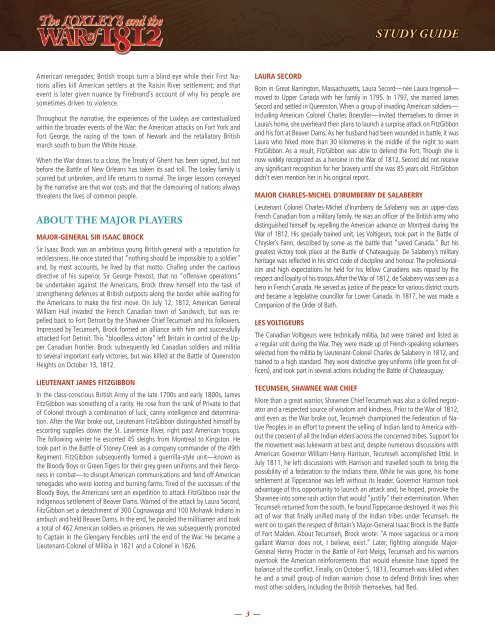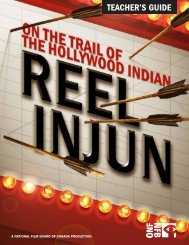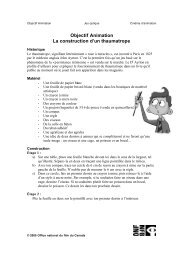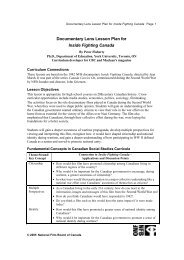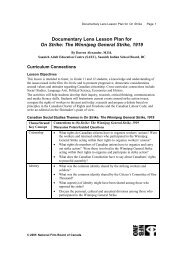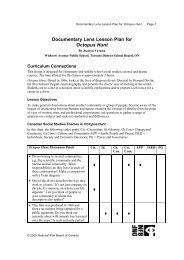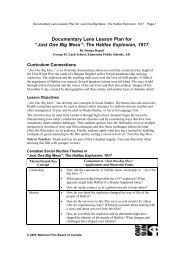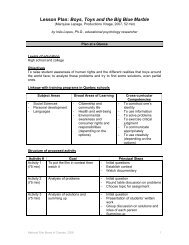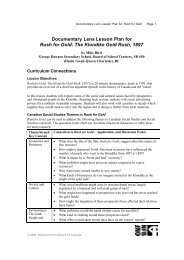Study guide - Office national du film du Canada
Study guide - Office national du film du Canada
Study guide - Office national du film du Canada
- No tags were found...
You also want an ePaper? Increase the reach of your titles
YUMPU automatically turns print PDFs into web optimized ePapers that Google loves.
STUDY GUIDEAmerican renegades; British troops turn a blind eye while their First Nationsallies kill American settlers at the Raisin River settlement; and thatevent is later given nuance by Firebrand’s account of why his people aresometimes driven to violence.Throughout the narrative, the experiences of the Loxleys are contextualizedwithin the broader events of the War: the American attacks on Fort York andFort George, the razing of the town of Newark and the retaliatory Britishmarch south to burn the White House.When the War draws to a close, the Treaty of Ghent has been signed, but notbefore the Battle of New Orleans has taken its sad toll. The Loxley family isscarred but unbroken, and life returns to normal. The larger lessons conveyedby the narrative are that war costs and that the clamouring of nations alwaysthreatens the lives of common people.ABOUT THE MAJOR PLAYERSMAJOR-GENERAL SIR ISAAC BROCKSir Isaac Brock was an ambitious young British general with a reputation forrecklessness. He once stated that “nothing should be impossible to a soldier”and, by most accounts, he lived by that motto. Chafing under the cautiousdirective of his superior, Sir George Prevost, that no “offensive operations”be undertaken against the Americans, Brock threw himself into the task ofstrengthening defences at British outposts along the border while waiting forthe Americans to make the first move. On July 12, 1812, American GeneralWilliam Hull invaded the French Canadian town of Sandwich, but was repelledback to Fort Detroit by the Shawnee Chief Tecumseh and his followers.Impressed by Tecumseh, Brock formed an alliance with him and successfullyattacked Fort Detroit. This “bloodless victory” left Britain in control of the UpperCanadian frontier. Brock subsequently led Canadian soldiers and militiato several important early victories, but was killed at the Battle of QueenstonHeights on October 13, 1812.LIEUTENANT JAMES FITZGIBBONIn the class-conscious British Army of the late 1700s and early 1800s, JamesFitzGibbon was something of a rarity. He rose from the rank of Private to thatof Colonel through a combination of luck, canny intelligence and determination.After the War broke out, Lieutenant FitzGibbon distinguished himself byescorting supplies down the St. Lawrence River, right past American troops.The following winter he escorted 45 sleighs from Montreal to Kingston. Hetook part in the Battle of Stoney Creek as a company commander of the 49thRegiment. FitzGibbon subsequently formed a guerrilla-style unit—known asthe Bloody Boys or Green Tigers for their grey green uniforms and their fiercenessin combat—to disrupt American communications and fend off Americanrenegades who were looting and burning farms. Tired of the successes of theBloody Boys, the Americans sent an expedition to attack FitzGibbon near theindigenous settlement of Beaver Dams. Warned of the attack by Laura Secord,FitzGibbon set a detachment of 300 Cognawaga and 100 Mohawk Indians inambush and held Beaver Dams. In the end, he paroled the militiamen and tooka total of 462 American soldiers as prisoners. He was subsequently promotedto Captain in the Glengarry Fencibles until the end of the War. He became aLieutenant-Colonel of Militia in 1821 and a Colonel in 1826.LAURA SECORDBorn in Great Barrington, Massachusetts, Laura Secord—née Laura Ingersoll—moved to Upper <strong>Canada</strong> with her family in 1795. In 1797, she married JamesSecord and settled in Queenston. When a group of invading American soldiers—including American Colonel Charles Boerstler—invited themselves to dinner inLaura’s home, she overheard their plans to launch a surprise attack on FitzGibbonand his fort at Beaver Dams. As her husband had been wounded in battle, it wasLaura who hiked more than 30 kilometres in the middle of the night to warnFitzGibbon. As a result, FitzGibbon was able to defend the Fort. Though she isnow widely recognized as a heroine in the War of 1812, Secord did not receiveany significant recognition for her bravery until she was 85 years old. FitzGibbondidn’t even mention her in his original report.MAJOR CHARLES-MICHEL D’IRUMBERRY DE SALABERRYLieutenant Colonel Charles-Michel d’Irumberry de Salaberry was an upper-classFrench Canadian from a military family. He was an officer of the British army whodistinguished himself by repelling the American advance on Montreal <strong>du</strong>ring theWar of 1812. His specially trained unit, Les Voltigeurs, took part in the Battle ofChrysler’s Farm, described by some as the battle that “saved <strong>Canada</strong>.” But hisgreatest victory took place at the Battle of Chateauguay. De Salaberry’s militaryheritage was reflected in his strict code of discipline and honour. The professionalismand high expectations he held for his fellow Canadiens was repaid by therespect and loyalty of his troops. After the War of 1812, de Salaberry was seen as ahero in French <strong>Canada</strong>. He served as justice of the peace for various district courtsand became a legislative councillor for Lower <strong>Canada</strong>. In 1817, he was made aCompanion of the Order of Bath.LES VOLTIGEURSThe Canadian Voltigeurs were technically militia, but were trained and listed asa regular unit <strong>du</strong>ring the War. They were made up of French-speaking volunteersselected from the militia by Lieutenant-Colonel Charles de Salaberry in 1812, andtrained to a high standard. They wore distinctive grey uniforms (rifle green for officers),and took part in several actions including the Battle of Chateauguay.TECUMSEH, SHAWNEE WAR CHIEFMore than a great warrior, Shawnee Chief Tecumseh was also a skilled negotiatorand a respected source of wisdom and kindness. Prior to the War of 1812,and even as the War broke out, Tecumseh championed the Federation of NativePeoples in an effort to prevent the selling of Indian land to America withoutthe consent of all the Indian elders across the concerned tribes. Support forthe movement was lukewarm at best and, despite numerous discussions withAmerican Governor William Henry Harrison, Tecumseh accomplished little. InJuly 1811, he left discussions with Harrison and travelled south to bring thepossibility of a federation to the Indians there. While he was gone, his homesettlement at Tippecanoe was left without its leader. Governor Harrison tookadvantage of this opportunity to launch an attack and, he hoped, provoke theShawnee into some rash action that would “justify” their extermination. WhenTecumseh returned from the south, he found Tippecanoe destroyed. It was thisact of war that finally unified many of the Indian tribes under Tecumseh. Hewent on to gain the respect of Britain’s Major-General Isaac Brock in the Battleof Fort Malden. About Tecumseh, Brock wrote: “A more sagacious or a moregallant Warrior does not, I believe, exist.” Later, fighting alongside Major-General Henry Procter in the Battle of Fort Meigs, Tecumseh and his warriorsovertook the American reinforcements that would elsewise have tipped thebalance of the conflict. Finally, on October 5, 1813, Tecumseh was killed whenhe and a small group of Indian warriors chose to defend British lines whenmost other soldiers, including the British themselves, had fled.— 3 —


